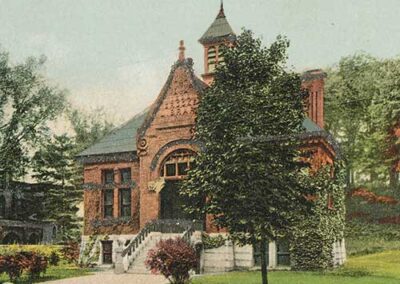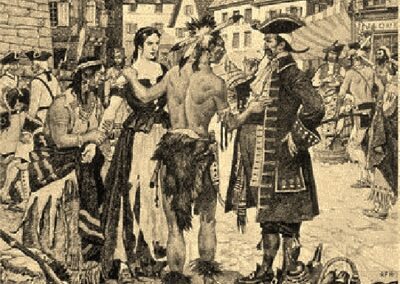WANTASTIQUET MOUNTAIN
A Brattleboro Words Trail Site
A Land Acknowledgement
Like every place in the United States, Brattleboro was built on stolen land, and the European settlers who came here during the colonial period did everything they could to drive out the Indigenous people who lived here. Those people are the Sokoki Abenaki (or, translated into English from the original Sokwakiak, the People Who Separated), and despite centuries of persecution they survive today. Their native tongue, Aln8ba8dwaw8gan—the Western Abenaki language—survives as well, but is greatly endangered. To the Sokoki Abenaki, this place is known as Wantastegok, the Place of the River Where Things Are Lost, referring to the confluence of Kwenitekw with Wantastekw, what we now call the Connecticut River and the West River. Every corner of this land holds their stories. This research site on the Brattleboro Words Trail documents the history and enduring presence of the Sokoki Abenaki and their homeland, Wantastegok.
Foremost among Brattlebroro’s many striking geographical features is Mount Wantastiquet. Rising some 1300 feet above sea level in Chesterfield, New Hampshire, the mountain looms over downtown Brattleboro from across the Kwenitekw/Connecticut River—a long, lush shoulder glittering green in spring and summer, burning red, orange, and gold through autumn, and blanketed white in winter.
Over the centuries, the mountain’s natural and cultural significance has been—and continues to be—captured in the words of countless locals and visitors, from picnickers, miners, and rattlesnake victims to Henry David Thoreau.
Naming the Land: At the Place of the Lost River
Rich Holschuh, Words Project researcher and public liaison for the Elnu Abenaki Tribe, illuminates the significance of the mountain’s name:
For the record, the mountain has had several different monikers since European settlement: Chesterfield Mountain (after the NH town within whose borders most of its bulk lies), Rattlesnake Mountain (after the population of timber rattlers that frequented its talus slopes), West River Mountain (more on that momentarily), and the current identifier, Wantastiquet. It is gratifying that the latter name has persisted, as it is very close to the Sokoki Abenaki placename for this landmark.
The challenging spelling, of course, derives from its Abenaki origin but here the story takes a turn, as often happens with transliteration of native names. The mountain is, in fact, named after the tributary river which meets the main stem at its base, so by learning the source of the name we come to understand both features. Now called the West River (and thus the West River Mountain extrapolation), the Western Abenaki know it as Wantastekw; consequently, the long mountain which faces its confluence with the Kwanitekw is Wantastegok Wajo.
We’ll work our way through the meanings… Conventional wisdom has it that “West River” is a simplification of the assumed meaning of “Wantastiquet,” usually given as “river that leads to the west.” Unfortunately, that translation is substantially off-base. Working with the original form Wantastekw, let us note the Abenaki word for “west” is ali-nkihl8t and no form of that noun appears here. More to the point, Western Abenaki linguist Jesse Bruchac has lent some clarity to the meaning of wantas- : wan- (the root inside wantas-) can mean “forget or lost.” In this case: wantas = “a lost or misplaced thing” and tekw = flow (the ending -tekw is a commonly encountered Western Abenaki bound morpheme for “flow,” as in the moving water of a river).
As an illustrative aside, it is interesting to note that wantastasid = “one who gives bad traveling directions.” Gordon Day recorded its meaning rather concisely: “literally: lost river, i.e. river on which it is easy to get lost or easy to lose the right trail.”
As for Wantastegok Wajo (the mountain itself), the -ok ending is a common bound locative suffix meaning “at the place of” and wajo is a free morpheme for “mountain.” Put it all together and we have “the mountain at the place of the lost river.” It’s not the river which is lost, but rather the unfamiliar traveler.
Also, it is fair to mention that there are a number of other citations of the river’s original name Wantastekw being translated as “waters of the lonely way,” which hearkens much closer to the true meaning than today’s West River. And in a broader sense, a further extension of the usage of the name Wantastekw is the understanding that it was used by the Sokoki (and probably the earliest Europeans) to refer to the immediate locality we now know as Brattleboro. In this case, the proper Abenaki form would be Wantastegok, which would mean simply: “at the place of the lost river.”
The text here was originally published in an article on Sokoki Sojourn: Observations and Experiences in the Kwenitekw Dawnland.
“…this everlasting mountain is forever lowering over the village, shortening the day and wearing a misty cap each morning. You look up to its top at a steep angle from the village streets. A great part belongs to the Insane Asylum. This town will be convicted of folly if they ever permit this mountain to be laid bare.”
— Henry David Thoreau (Journal, 9:70-4)
Thoreau on Wantastiquet
On September 5th, 1856 (the same year that famous photo of him was taken) Thoreau left Concord for Walpole, New Hampshire to visit a fellow transcendentalist, Amos Bronson Alcott. Before getting to Walpole, Thoreau stopped for a four-day visit with Addison Brown and his family in Brattleboro, Vermont.
It was during his stay in Brattleboro that Thoreau climbed Wantastiquet, then called Chesterfield Mountain, located just across the boarder in Chesterfield, New Hampshire.
Two of Addison’s five children, Frances and Mary Brown, accompanied Thoreau to the mountain’s summit—about 1,335 feet (407 m). Thoreau and Mary would continue to correspond years later, often sending each other botanical specimens not native to the other’s area.
On The Map
244 Mountain Road, West Chesterfield, NH
Wantastiquet Mountain
About the Research sites
The Brattleboro Words Project is working with the community to identify specific sites and themes significant to the study of words in Brattleboro and surrounding towns. Research Teams – classrooms/teachers, amateur historians, veterans, writers, artists and other community members — will produce audio segments and other work to be incorporated into audio walking, biking and driving tours tours.
Research Team Leader
[/et_pb_staff]









